Is Wynne’s new Ontario cabinet reviving old ideals about parliamentary democracy (probably not, but …)?
Jun 26th, 2014 | By Randall White | Category: In Brief The genius of the traditional “Westminster” or British-style cabinet system is or at least was supposed to be that it is an authentically collegial or team-management approach to the increasingly complicated adventures of government by popularly elected officials.
The genius of the traditional “Westminster” or British-style cabinet system is or at least was supposed to be that it is an authentically collegial or team-management approach to the increasingly complicated adventures of government by popularly elected officials.
Any modern parliamentary democracy is far too complicated to be navigated by the mind of just one human being. Cabinet government on the Westminster model spreads the heavy responsibility for the various branches of what government does around, to get closer to the ground. The first or prime minister or premier is just primus inter pares –Â first among equals, in charge of the department of general oversight. (And in the spirit of: What is our ultimate broad/high policy etc, anyway? Some journalist has been asking.)
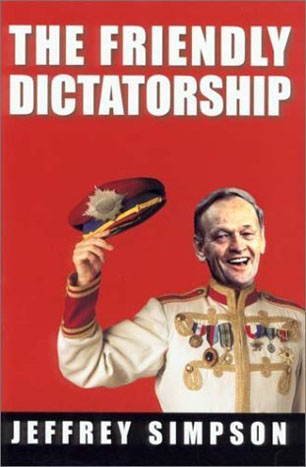 Alas, that is or was the dream, back in the days of Winston Churchill’s grandfather (or just his Red Tory father?, and not his American grandparents of course), etc. Nowadays, in virtually all practising Westminster systems (eg, Australia, Canada, the world’s largest democracy in India, Ireland, New Zealand, Trinidad & Tobago, and of course the United Kingdom itself) the office of prime minister has for some time, and with some notable success in some places, been turning the first or prime minister or premier into something much grander than first among equals.
Alas, that is or was the dream, back in the days of Winston Churchill’s grandfather (or just his Red Tory father?, and not his American grandparents of course), etc. Nowadays, in virtually all practising Westminster systems (eg, Australia, Canada, the world’s largest democracy in India, Ireland, New Zealand, Trinidad & Tobago, and of course the United Kingdom itself) the office of prime minister has for some time, and with some notable success in some places, been turning the first or prime minister or premier into something much grander than first among equals.
(And the argument here, it seems, is that only the mind of just one human being can reduce the dramatically increasing variety of the global village to manageable proportions. And again this argument may be, and even probably is, quite wrong. See, eg, the Canadian journalist Jeffrey Simpson’s book of 2001 on The Friendly Dictatorship in Ottawa, even before Stephen Harper.)
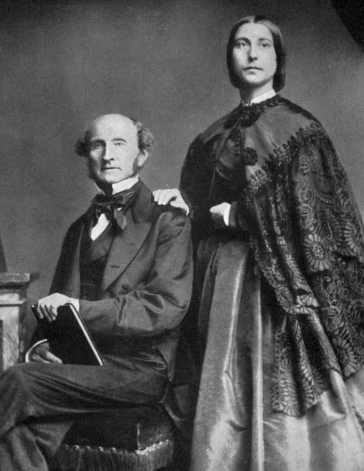
John Stuart Mill and Helen Taylor, daughter from an earlier marriage of Mill’s wife Harriet Taylor, who died of acute lung congestion after only seven years of her marriage to Mill. John Stuart Mill was both a great 19th century theorist of “government by discussion” and an early male advocate for the rights of women. One might guess that he would be enthused about the premiership of Kathleen Wynne, far away in what used to be called British North America.
It would certainly be too much to say that the June 24, 2014 swearing-in of Kathleen Wynne’s new provincial cabinet at Queen’s Park in Ontario marked some welcome regional revival of the alleged more traditional Westminster model – from the days when it first became thoroughly democratic, so to speak. In what a Toronto historian in the 1930s called (not entirely happily, to say nothing of truthfully, even then) “the most British of all the provinces” in Canada.
In her remarks yesterday Premier Wynne nonetheless did say that there are no higher or lower jobs in her cabinet. There is certainly a side of her that is not afraid of showing leadership. But she has also been a cabinet minister herself. She knows and respects just how challenging it is to do any kind of good job managing any branch of the great many practical and even needed things that a Canadian provincial government does in the early 21st century. She appears to want some kind of more collegial cabinet – as a way of avoiding at least the most obvious mistakes, whatever else! But talking things out, in the old Westminster spirit of “government by discussion,” also seems to be her particular democratic style.
1. Back to the future of Leslie Frost on “economic advance and human betterment” ??
 Meanwhile, back with the side of Kathleen Wynne that is not afraid of showing leadership, her new cabinet suggests she is determined to work hard at doing both of two rather different things together – things that much current conventional wisdom regards as incompatible.
Meanwhile, back with the side of Kathleen Wynne that is not afraid of showing leadership, her new cabinet suggests she is determined to work hard at doing both of two rather different things together – things that much current conventional wisdom regards as incompatible.
She is determined to keep faith with the activist role of government in aid of the people as shown in finance minister Charles Sousa’s May 2014 budget document. And she is also determined to keep faith with the same budget document’s deadly serious commitment to balance the Ontario budget by the 2017—18 fiscal year.

Toronto Mayor Allan Lamport (l) and Ontario Premier Leslie Frost (r) take inaugural trip on the Yonge subway in the provincial capital, March 30, 1954.
There are still more than a few who say this is all impossible (many of whom don’t want it to be possible in any case, of course). Time will tell. History sometimes does seem to support none of the above in our various great debates these days.
And yet, only a little more optimistically, maybe all Kathleen Wynne wants to do is revive the real Progressive Conservative Leslie Frost’s 1950s view of Ontario provincial government as “a partnership between the two philosophies of economic advance and human betterment.” (Which also seems to be what NDP leader Andrea Horwath now wants too – so she can start attacking the government from the left again … )
Meanwhile, on what is arguably a related current of traditional Westminster principles, Premier Wynne has spread around the no doubt vastly challenging responsibility for meeting the two commitments together – and keeping faith with both philosophies of economic advance and human betterment at the same time.
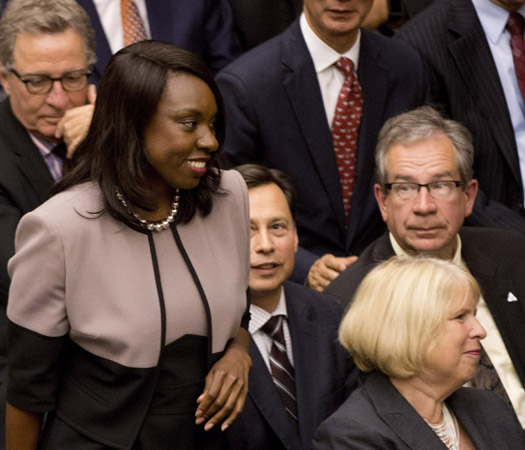
Mitzie Hunter (l) , will take responsibility for new Ontario Pension Plan, while finance minister Charles Sousa concentrates on balancing the budget by 2017--2018. She appears here at the June 24 swearing-in, just behind Deb Matthews (r), new President of the Treasury Board and Minister Responsible for the Poverty Reduction Strategy.
Thus the ultimate financial picture is no longer in the first place just a matter for the premier and her finance minister. Now they both have the added support of Deb Matthews, President of the Treasury Board, Minister Responsible for the Poverty Reduction Strategy, and Mitzie Hunter, Associate Minister of Finance (Ontario Retirement Pension Plan).
Already there are those too facile minds who are seeing all this as a kind of demotion for Charles Sousa – who now has two other people trying to do his job with him. But at best this may be too hasty a view. As the official Ontario Newsroom announcement explains : “Charles Sousa returns as Minister of Finance. His primary focus will be balancing the budget by 2017-18.”
In several respects, the June 12 election was about choosing between two different ways of understanding and managing the problems of the Ontario regional economy today (insofar as any mere provincial government can actually do such a thing, of course).
 It does appear that many of those who would and even do see the new Ontario cabinet as a “demotion” for finance minister Sousa lost on June 12. Those of us who won would at least like to remain in a more optimistic frame of mind for a few more months yet, before breaking out all the doom and gloom all over again. (And certainly for all those lazy, hazy days of summer ahead at the lake and the more northern beaches, with goddesses in bathing suits, and whatever else the warmer weather might bring.)
It does appear that many of those who would and even do see the new Ontario cabinet as a “demotion” for finance minister Sousa lost on June 12. Those of us who won would at least like to remain in a more optimistic frame of mind for a few more months yet, before breaking out all the doom and gloom all over again. (And certainly for all those lazy, hazy days of summer ahead at the lake and the more northern beaches, with goddesses in bathing suits, and whatever else the warmer weather might bring.)
Premier Wynne seems to be promising that, when the Legislative Assembly starts up again this coming July 2, she will just quickly get the budget passed, and then let the Clear Grit (and other) MPPs get back to the growing season on their hard-earned family farms. And even for those of us just watching our grass grow in July and August, in various incarnations of urban, suburban, and exurban areas in the early 21st century, that does seem an excellent policy. Ms Wynne and her staff will continue to work through the summer, of course. And so will some of us here on this site, I am told. And that’s all wonderful too.
2. The new Ontario cabinet in order of precedence (I think) …
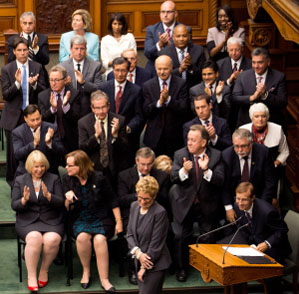
The new cabinet in order of precedence, more or less. Jim Bradley is in the middle of the first row, directly behind the premier. Mitzie Hunter is in the back row, extreme right, beside Steven Del Duca, who is just to the right of Dipika Damerla.
Premier Wynne may imply as much as she likes that everyone is equal in her cabinet. There are always many others out there somewhere trying hard to figure out who’s up and who’s down. That is, as they say, part of the blood sport that is parliamentary democratic politics. (Well, not as bloody in Canada’s most populous province of Ontario as in some places, of course … but …)
Below in any case is the new Ontario cabinet, in what I believe is known as order of precedence. This is a subset of a larger and vaguely monarchical Order of this sort – in Ontario, Canada, and who knows where else, as nowadays at least somewhat written up even in (or on?) Wikipedia.
Apart from such obvious enough precedence for such things as premier and deputy premier (even first among equals still means first, etc), the main ranking variable here would seem to be seniority in terms of years served in the Legislative Assembly. (And thus, if you like, also and more importantly, years served as elected by the sovereign people, to represent your riding.)
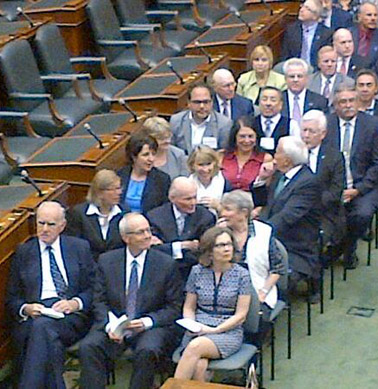
Former Premiers Bill Davis (middle, second row), Bob Rae (right, fourth row), and David Peterson (right, third row) are guests at swearing-in of Kathleen Wynne govt. Thanks to Paul Bliss, CTV.
Thus Jim Bradley, who has represented St. Catharines in the legislature since 1977, logically enough is third in precedence, even apart from his status as “Chair of Cabinet, Deputy Government House Leader.” And Mitzie Hunter – Associate Minister of Finance (Ontario Retirement Pension Plan : a job for which she has arguably been trained by the patrician Toronto business wizard and current mayoral candidate John Tory) – was only elected in a comparatively recent by-election, and then elected again on June 12. So she could logically be at the bottom of a seniority-by-years-served list.
I haven’t done any further calculations of this sort for any of the other 23 cabinet ministers in between Jim Bradley and Mitzie Hunter. And of course I may be wrong in my stress on years served etc. Here in any case are all 26 ministers in Kathleen Wynne’s new June 24, 2014 cabinet (along with Premier Wynne herself). In order of precedence I believe, and for certain as given in the official Liberal Ontario announcement – and other announcements in the media (including one where Mitzie Hunter, already at the bottom, as the newbie on the block, gets left off the list altogether) :
Kathleen Wynne, Don Valley West
Premier and President of the Council, Minister of Intergovernmental Affairs
(1) Deb Matthews, London North Centre
Deputy Premier, President of the Treasury Board, Minister Responsible for the Poverty Reduction Strategy
(2) Jim Bradley, St. Catharines
Chair of Cabinet, Deputy Government House Leader
(3) Michael Gravelle, Thunder Bay–Superior North
Minister of Northern Development and Mines
(4) Ted McMeekin, Ancaster–Dundas–Flamborough–Westdale
Minister of Municipal Affairs and Housing
(5) Brad Duguid, Scarborough Centre
Minister of Economic Development, Employment and Infrastructure
(6) Jeff Leal, Peterbrough
Minister of Agriculture, Food and Rural Affairs
(7) Madeleine Meilleur, Ottawa–Vanier
Attorney General, Minister Responsible for Francophone Affairs
(8) David Orazietti, Sault Ste. Marie
Minister of Government and Consumer Services
(9) Liz Sandals, Guelph
Minister of Education
(10) David Zimmer, Willowdale
Minister of Aboriginal Affairs
(11) Michael Chan, Markham–Unionville
Minister of Citizenship, Immigration and International Trade
(12) Reza Moridi, Richmond Hill
Minister of Research and Innovation, Minister of Training, Colleges and Universities
(13) Yasir Naqvi, Ottawa Centre
Minister of Community Safety and Correctional Services, Government House Leader
(14) Charles Sousa, Mississauga South
Minister of Finance
(15) Eric Hoskins, St. Paul’s
Minister of Health and Long-Term Care
(16) Glen Murray, Toronto Centre
Minister of the Environment and Climate Change
(17) Bob Chiarelli, Ottawa West–Nepean
Minister of Energy
(18) Michael Coteau, Don Valley East
Minister of Tourism, Culture and Sport, Minister Responsible for the 2015 Pan/Parapan American Games
(19) Tracy MacCharles, Pickering–Scarborough East
Minister of Children and Youth Services, Minister Responsible for Women’s Issues
(20) Mario Sergio, York West
Minister Responsible for Seniors Affairs
(21) Kevin Flynn, Oakville
Minister of Labour
(22) Bill Mauro, Thunder Bay–Atikokan
Minister of Natural Resources and Forestry
(23) Helena Jaczek, Oak Ridges–Markham
Minister of Community and Social Services
(24) Dipika Damerla, Mississauga East–Cooksville
Associate Minister of Health and Long-Term Care (Long-Term Care and Wellness)
(25) Steven Del Duca, Vaughan
Minister of Transportation
(26) Mitzie Hunter, Scarborough–Guildwood
Associate Minister of Finance (Ontario Retirement Pension Plan)
3. A more democratic newsroom …

Amanda Pokhoy, left, and K.C. Tohm were teammates on the Oliver Mowat Collegiate Institute senior girl's volleyball squad, which played in the City of Toronto finals for the sixth-straight year in the late winter of 2012. Oliver Mowat was the founder of Ontario’s first Liberal “Great Reform” dynasty of the late 19th and early 20th centuries. One might guess that he would be enthusiastic about Premier Kathleen Wynne too.
In case you find a listing of cabinet ministers in order of precedence almost entirely beside the point, a government site called “Newsroom … Ontario’s official news source” gives Kathleen Wynne’s new June 24, 2014 cabinet in strict alphabetical order.
This is arguably the most democratic arrangement. And in this version Jim Bradley jumps from third to first place – because his surname begins with a B. And Premier Wynne is second-last on the list, just before David Zimmer, Minister of Aboriginal Affairs.
It is intriguing as well, I think, that this most-democratic, strictly alphabetical listing is what you get if you click on “Meet the Team” at the official website for the Office of the Premier. And it seem not unreasonable to guess that this may reveal something of the current premier’s particular intentions.
4. The largest spending ministries …
One highly inexact way of trying to judge who carries more or less weight than who in a Westminster cabinet is to rank ministers by the size of their budgets. Here are the current top half-dozen:
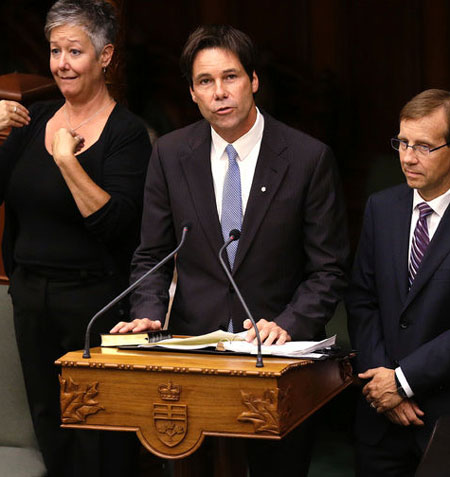
Dr. Eric Hoskins reads the oath at the swearing in ceremony as health minister at Queen's Park in Toronto on Tuesday, June 24, 2014. (Craig Robertson/Toronto Sun).
(1) According to the “Plan 2014—15” numbers in Charles Sousa’s May 2014 Ontario Budget, which Premier Wynne is apparently now determined to promptly pass more or less intact with her new legislative majority, the Ministry of Health and Long Term Care – with a current proposed budget of just over $50 billion, accounting for almost 39% of total provincial spending – is by far and away the largest-spending ministry in Ontario today. Its new minister, Eric Hoskins, from the downtown Toronto riding of St. Paul’s, is a medical doctor with a public health track record, who has apparently (albeit inexplicably) wanted this very difficult job for some time. Here (as in the case of Charles Sousa in Finance) the senior minister will also be assisted, in this instance by Dipika Damerla from Mississauga East–Cooksville, serving as Associate Minister of Health and Long-Term Care (Long-Term Care and Wellness).
(2) The Ministry of Education, with a current budget just under $25 billion, accounting for just over 19% of total provincial spending, is the unambiguous #2 big spender. Liz Sandals, from the Guelph riding just northwest of the GTA, helped resolve some earlier teacher-bargaining issues for Kathleen Wynne’s first (unelected – and minority) cabinet. And she is staying on as Minister of Education in the new elected majority government. (Because, as we in Ontario who read about the teachers’ strike in beautiful BC might guess, her skills in bargaining with teachers may very well be needed again – and again?– over the next four years.)
(3) The third biggest spender in Ontario today is Community and Social Services, with a budget of not quite $11 billion, accounting for just over 8% of total spending. Its new minister is Helena Jaczek from the exurban Toronto riding of Oak Ridges–Markham. She was first elected in 2007 and now has a good half-dozen years in such trenches as Member, Standing Committee on Social Policy; Parliamentary Assistant to the Minister of the Environment ; Caucus Chair ; and Parliamentary Assistant to the Minister of Health and Long-Term Care.
(4) According to the May 2014 Budget document, the Ministry of Training, Colleges and Universities is slated to spend some $7.8 billion or 6% of the provincial total in 2014—2015. The new June 24 Minister of Training, Colleges and Universities, Reza Moridi from the exurban Toronto riding of Richmond Hill (also Premier Wynne’s hometown), is also Minister of Research and Innovation. In the May 2014 Budget document, however, “Research and Innovation” is linked up with the Ministry of Economic Development, Trade and Employment. At the same time again, Brad Duguid from Scarborough Centre is now Minister of Economic Development, Employment and Infrastructure – and “Trade” has flung still further into the waiting arms of Michael Chan from Markham–Unionville, the new Minister of Citizenship, Immigration and International Trade. All this makes you wonder exactly how all the re-labelling has come about. Does a prospective cabinet member just say to the new and maybe more collegial premier, “Well I’m also getting pretty interested in Infrastructure too,” or maybe “International Trade”? Is this another instance of Premier Wynne’s taste for the old Westminster spirit of “government by discussion”? In any case, it seems likely that Reza Moridi, Minister of Research and Innovation, Minister of Training, Colleges and Universities will be spending something closer to $8 billion in the 2014-2015 fiscal year
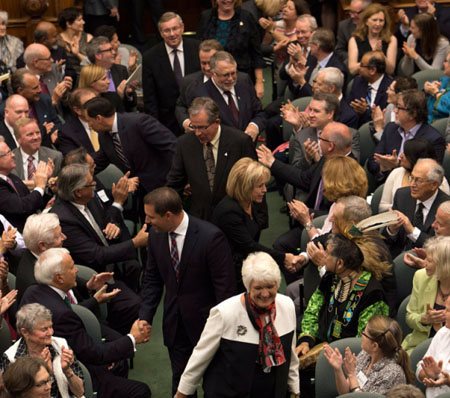
Education is the second-largest-spending ministry. Ibnfluential Minister bof Education Liz Sandals (centre foreground, in white ... and black) greets guests at swearing-in on June 24.
(5) The Ministry of Children and Youth Services will be spending more than $4.2 billion in 2014—2015. Tracy MacCharles from Pickering–Scarborough East in the GTA is the new Minister of Children and Youth Services (and also the Minister Responsible for Women’s Issues). She had earlier served in Kathleen Wynne’s first cabinet, sworn in on February 11, 2013, as Minister of Consumer Services.
(6) The Ministry of Transportation will be spending more than $3 billion in 2014—2015. The new Minister of Transportation is Steven Del Duca, from Vaughan, just north of the present megacity of Toronto. He appears to have only slightly more seniority than Mitzie Hunter, dating back to a 2012 rather than a 2013 by-election. But Del Duca was also a former aide to Dalton McGuinty – way back when McGuinty was a mere opposition leader. And, as explained by Wikipedia : “Prior to his election Del Duca was director of public affairs for the Carpenters’ District Council of Ontario.”
5. Geographic representation and all that again
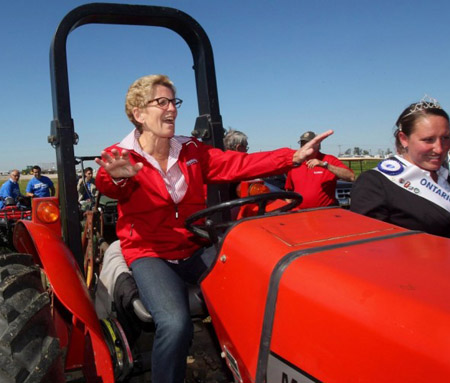
Kathleen Wynne sits in a tractor warning bystanders she is about to move, as she participates in a celebrity plowing display at the 100th annual International Plowing Match near Mitchell, Ont., Sept. 17, 2013. THE CANADIAN PRESS/Dave Chidley.
Geographic or regional representation has long been viewed as a key part of political cabinet-making in Canada. And the criticism that the new Wynne majority is too Toronto-Centred in the wider world of Ontario is, if anything, at least just as if not more true for the new cabinet, as for the Liberal majority caucus.
On a very quick back-of-the-envelope calculation, I’d tentatively list the regional assignment of seats at the table in Kathleen Wynne’s new cabinet of June 24, 2014 as follows (including Premier Wynne herself, for a total of 27) : Toronto 416 – 8 ;Â Toronto 905 – 8 ;Â Ottawa/East – 3 ; Southwest-Hamilton-Niagara – 3 ; North – 3 ; Central – 2.
Even as a long-term Torontonian, I can agree that these numbers probably are too Toronto-Centred. And even the Wynne majority government is going to need to keep reaching out to the various complex regional geographies of today, too often too crudely summarized as Rural Ontario.
6. See You In September?
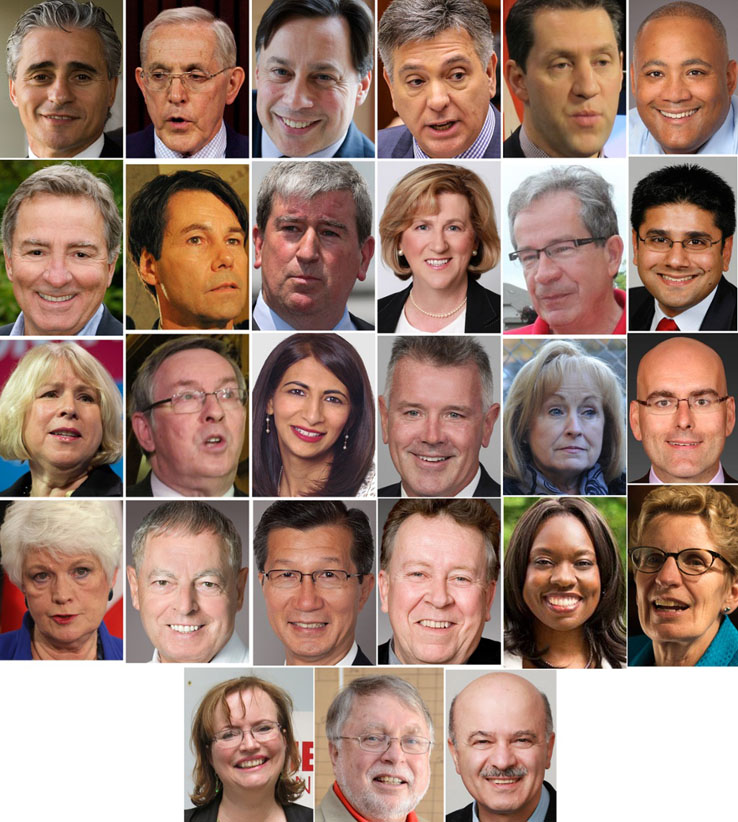
From top, left to right, to bottom, left to right : Bill Mauro, Minister of Natural Resources and Forestry ; Bob Chiarelli, Minister of Energy ; Brad Duguid, Minister of Economic Development, Employment and Infrastructure ; Charles Sousa, Minister of Finance ; David Orazietti, Minister of Government and Consumer Services ; Michael Coteau, Minister of Tourism, Culture and Sport, Minister Responsible for the 2015 Pan and Parapan American Games ; David Zimmer, Minister of Aboriginal Affairs ; Dr. Eric Hoskins, Minister of Health and Long-Term Care ; Glen R. Murray, Minister of the Environment and Climate Change ; Dr. Helena Jaczek, Minister of Community and Social Services ; Jeff Leal, Minister of Agriculture, Food and Rural Affairs ; Yasir Naqvi, Minister of Community Safety and Correctional Services, Government House Leader ; Deb Matthews, Deputy Premier, President of the Treasury Board, Minister Responsible for the Poverty Reduction Strategy ; Jim Bradley, Chair of the Cabinet Deputy Government House Leader ; Dipika Damerla, Associate Minister of Health and Long-Term Care (Long-Term Care and Wellness) ; Kevin Flynn, Minister of Labour ; Madeleine Meilleur, Attorney General, Minister Responsible for Francophone Affairs ; Steven Del Duca, Minister of Transportation ; Liz Sandals, Minister of Education ; Mario Sergio, Minister Responsible for Seniors Affairs ; Michael Chan, Minister of Citizenship, Immigration and International Trade ; Michael Gravelle, Minister of Northern Development and Mines ; Mitzie Hunter, Associate Minister of Finance (Ontario Retirement Pension Plan) ; Kathleen Wynne Premier, Minister of Intergovernmental Affairs ; Tracy MacCharles, Minister of Children and Youth Services, Minister Responsible for Women's Issues ; Ted McMeekin, Minister of Municipal Affairs and Housing ; Reza Moridi,Minister of Training, Colleges and Universities, Minister of Research and Innovation.
I am trying to remember why I finally decided to spend far too much time on what was supposed to be a pretty simple report on the new Wynne cabinet of June 24, 2014. My best excuse, I think, is that I somehow (quite foolishly) wanted to show some kind of obscure solidarity with the new government in all its challenging new practical missions.
At any rate, now I feel I have shown my solidarity, as much as I need to. And I want to spend most of the rest of this summer essentially on holiday. As already noted, I have been told that some skeleton staff will be carrying on at counterweights world headquarters in East Toronto. And I think that’s wonderful too. But more or less from now to Labour Day – on Monday, September 1 this year – I will be at the lake and the beach (which in my case are also just at the foot of my street, in the ancient streetcar suburbs of the provincial capital city).
Meanwhile, I want to especially recommend Maria Babbage’s Canadian Press report on the new Wynne cabinet – “Wynne warns of ‘difficult choices’ ahead” – for further details and discussion, in some essentially objective spirit. From an aggressively partisan conservative (and Conservative) perspective, Christina Blizzard’s “Kathleen Wynne’s new cabinet: Meet Dr. No” is not without some kind of interest – and the partisanship is so shrill that it’s easy to discount. At the other end of the capital city newspaper spectrum, Martin Regg Cohn’s “Cabinet mandates tougher than election mandates” is in principle more favourable to the Wynne Liberals but still quite tough-minded.
Finally, it is a sometimes helpful rule of thumb that all important political changes in a parliamentary democratic government will be matched by parallel changes in the supporting professional public service personnel. And on June 25, 2014 – only one day after the swearing-in of her new cabinet – the Office of the Premier announced that “Kathleen Wynne has named Steve Orsini as Secretary of the Cabinet and Clerk of the Executive Council. He will lead the Ontario Public Service effective July 9, 2014 … Orsini has served as the Deputy Minister of Finance and Secretary of the Treasury Board since December 2011 … Orsini will succeed Peter Wallace, who will serve as the Ontario Visiting Fellow with the School of Public Policy and Governance at the University of Toronto for the coming academic year.”


